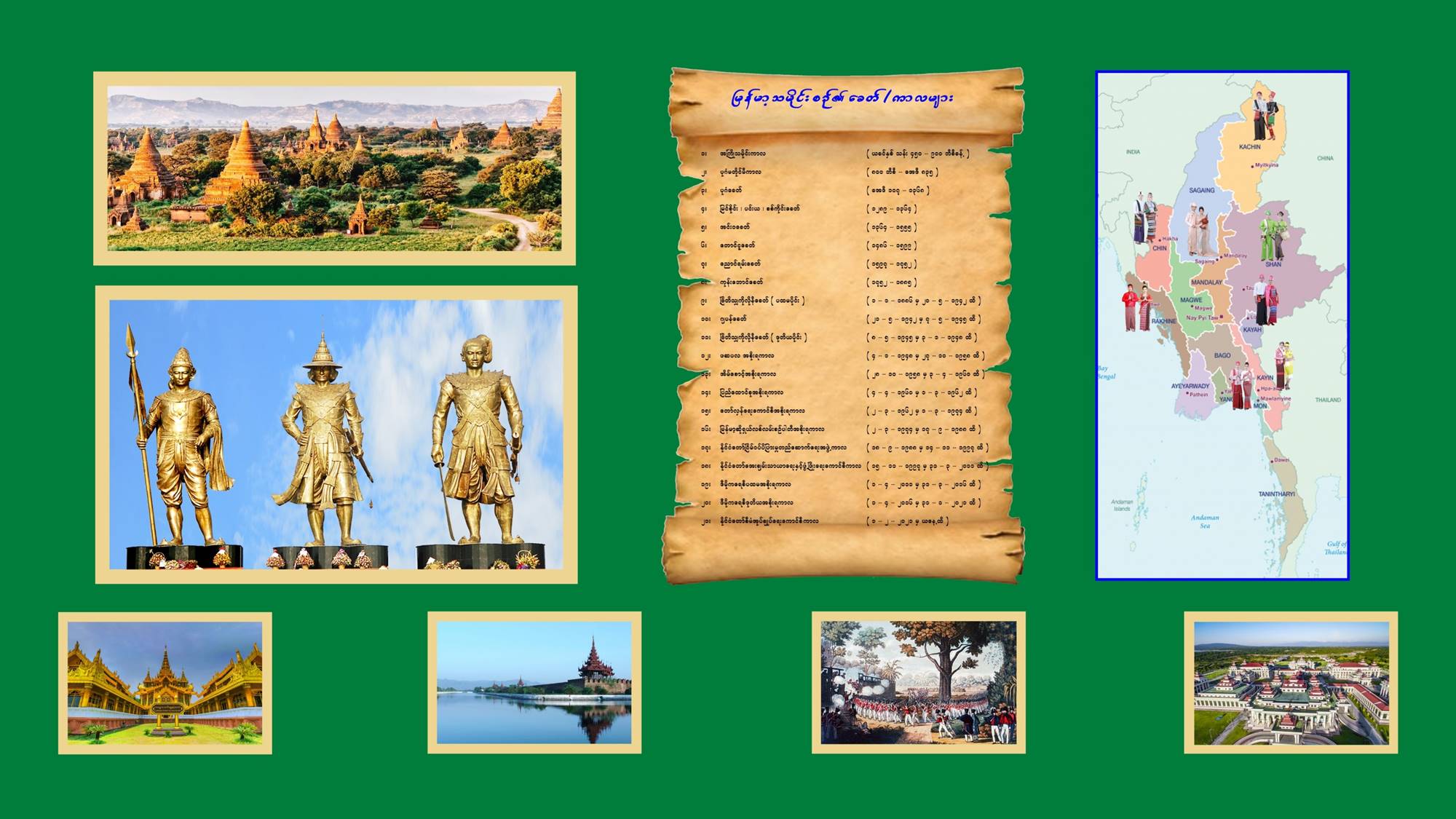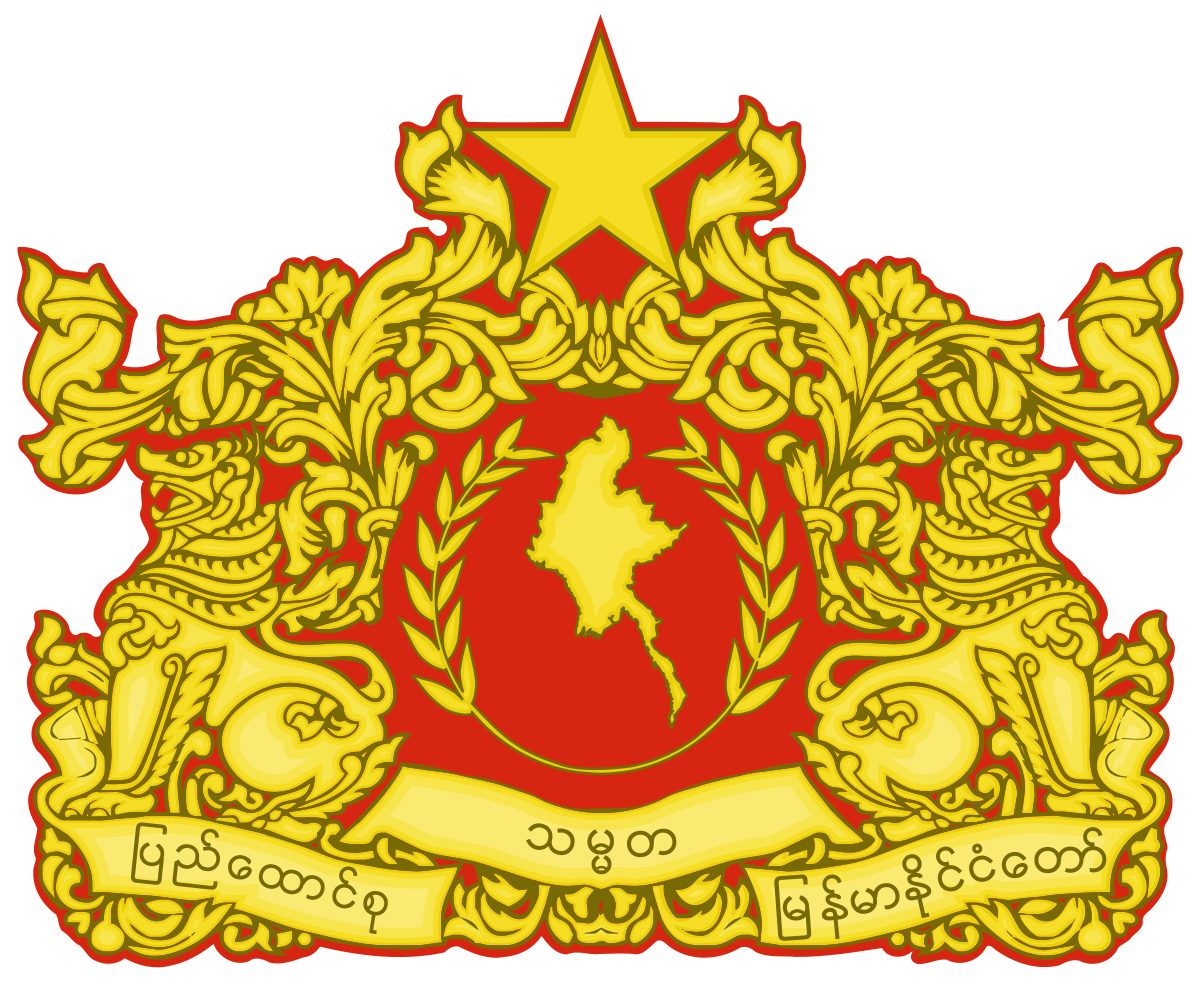History

A brief history of Myanmar
According to the jaw fragments of primates found in Myaing Township, Magway Division, Myanmar history can be assumed to have started 40 million years ago. Similarly, the discovery named Pondaungia found in Pondaung area and the discovery named Mogaungensis found near Mogaung village indicate that anthropoids have been living in Myanmar since 40 million years ago. A higher primate found in Pondaung area, Myanmar, called Dawn Ape with the scientific name of Amphipithecus, was tested to be 40 million years old.
Similarly, Myanmar, like other countries in the world, went through the Stone Age. Paleolithic humans have been living along the Irrawaddy River in Central Myanmar since the Middle Pleistocene. In 9000 BC (11,000 years ago), traces of Late Paleolithic and Early Neolithic civilizations was found in Padalin Cave. Neolithic humans lived in the Padalin cave from 5740 BC (7740 years ago) to 4570 BC (6570 years ago). Neolithic tools and weapons have been widely found in Tanintharyi in the south, in Putao in the north, from the foothills of Rakhine Yoma in the west to Thanlwin River in the east.
An archeological excavation of the Department of Archeology and National Museum found the evidence of the Late Bronze Age society around 900 BC in Nyaungkan area, Butalin Township; an early Iron Age society around 710 BC in Taung Thaman site; and between 530 BC and 90 BC, an Iron Age society between 530 BC and 90 BC in Ywar Htin Gone Village, Pyaw Bwe Township, Yamethin District, Mandalay Region, respectively. Therefore, the fact has been established that the Stone Age, Bronze Age, and Iron Age cultures flourished successively in Myanmar.
Entering the recorded history, the Pyu period existed between 100 BC and the 9th century AD, with the establishment of city-states. The centers of the Pyu civilization were the old cities of Han Lin, Sri Ksetra and Beikthano. The Pyu were able to record and inscribe their own literature on objects such as stone slab, votive tablets, golden palm leave manuscript, funeral urns. The Pyu people were able to establish city-states and lived prosperously with their own governments and their own cultures.
According to Myanmar Chronicles, Thamuddarit ruled 19 Bagan villages and crowned himself king at the place called Yonelhwat, 7 miles from the Irrawaddy River in 107 AD. In 167 AD during the reign of King Pyusawhti, the place was called Arimaddhana. In 344 A.D., during the reign of King Theylekyaung, the 19 villages were destroyed and a city was built in the place of Lawkananda and named Thiripyitsaya. In 516 AD, during the reign of King Thaik Tai, the capital was moved from Thiripyitsaya to the Ywar Seik village, and was named Tampavati. The city-states that emerged in early history of Myanmar around 9th Century were chaotic. Nevertheless, even in this situation, the ancients tried to create a New Country, and in 849 AD, King Pyinpya was able to establish the city of Bagan.
The 42nd among the 55 kings of Bagan dynasty, King Anawrahta (AD 1044-1077), established the first Myanmar Empire utilizing various military, economic, social means and put Myanmar on the world map. During the reign of King Nayathihapatae (AD 1256 - 1287), the political situation became unstable due to the economic crisis. Rebellion arose under the deteriorating authority of the king. In 1277, the Mongol invasion further destabilized the country and when Dala Sarr Kyaw Swar (1287-1298) succeeded to the throne of Bagan, the central authority was challenged by the three Shan-Myanmar princes; Athinkhayar, Yarzathingyan, and Thiha Thu, who had garnered great wealth and influence in the 11villages of Ledwin,Kyaukse District. At the time of ascension to the throne of Bagan by Saw Mon Hnit, the son of Saw Hnit in 1325, the authority of the Bagan Kingdom was merely hanging by a thread, and finally collapsed in 1368.
In 1312, the youngest of the three Shan-Myanmar princes, Thiha Thu established Pinya and named it Wizaya Pura, making it the royal capital. Thiha Thu had talented sons such as Uzanar, KyawSwar, Nawrahta, Athinkhayar Sawyun and Taraphyargyi. One of his sons, Athinkhayar Sawyun, consolidated the Northern Regions centered on Sagaing into a new Feudal Kingdom 1315. However, in 1364, the troops led by the Shan feudal lord Tho Chi Bwa attacked Tagaung, Pinya, and Sagaing fiercely, and during that year, the small kingdoms of Sagaing and Pinya were destroyed.
The person who reorganized the country after the collapse of Pinya and Sagaing was Thatoe Min Phyar, a descendant of Athinkhayar Sawyun. In 1364, the Kyi loch, Kyaukmaw loch, Intoo loch and Ohnnhe loch were banked up to make space for the founding of the new capital of Inwa or Ava. After the establishment of Ava, Thatoe Min Phyar carried out the reunification of the whole country, and due to the efforts of Thatoe Min Phyar and his successors, they were able to establish the First Ava Dynasty (1364-1555).
Simultaneously with the rise of Ava, on the other hand, Bago (Hantharwaddy) also emerged. In the following years, the people had to endure the 40-year war between Ava and Hanthawaddy, which was essentially a fierce competition between Ava and Bago (Hanthawaddy) feudal lords in the southern part of Myanmar.
During the reign of King Shwe Nan Kyawt Shin Narapati (1501-1527), the son of the King Mingaung the Second, Ava's situation was already in a state of decline. As the feudal state fo Taungoo became stronger, King Shwe Nang Kyawt Shin had to cede five watershed districts to Taungoo. During this unstable situation (1526-1527), Ava was attacked by Mohnyin Salone and his son Tho Han Bwar. Shwe Nan Kyawt Shin was executed, and Tho Han Bwar took over the throne of Ava (1527-1542). After the death of Minn Gyi Nyo in Taungoo in 1530 and the ascension of his son Tabin Shwehti to the throne, Tabin Shwehti gathered his strength to reunify the country. During the reign of King Bayinnaung, it was incorporated in to the newly formed Hantharwaddy Kingdom.
In the 16th century AD, King Bayinnaung spread his influence over the entire country and became the unrivaled suzerain in Myanmar, and was able to establish the Second Myanmar Empire. After taking over the central region, he went on to conquer the eastern, western, northern and southeastern regions of Myanmar as his weapon state, and became the land of Hantharwaddy. However, all the feudal states under the rule of King Bayinnaung were not always compliant, and prone to rebellion, so the majority of his reign was spent by constantly fighting wars of suppression throughout the kingdom. During the reign of Nanda Bayin, in 1599, Taungoo and Rakhine joined forces to attack Hantharwaddy, which ultimately destroyed the kingdom.
When the kingdom of Hantharwaddy was destroyed, the son of King Bayinnaung, of Lord of Nyaungyan, Minye´ Nandamate, established a new city in Ava, which had been depopulated and deteriorating for four years, and consolidated the upper part of Myanmar. With Ava as the center of power, the Nyaungyan Dynasty (AD 1600-1752) was established. In 1733, when Mahadhammaraza Dipadi came to the throne of Ava, internal, domestic and foreign threats became untenable. The situation became critical with the rebellion of Hantharwaddy peoples in the south, the rebellion led by Kunna Ain in Madayar and Oak Pho near Ava, and the invasions of Manipura (Kethe) who often encroached on the western border. In 1751, the troops of Uparaza, the brother of Hanthawaddy Banyardala(U Aung Hla), marched towards Ava by land and sea which ended Ava Dynasty in April 1752.
Out of this situation, the King Alaungpaya was able to reunite the entire country that was disintegrating and establish the Third Myanmar Empire also known as the Konbaung Dynasty (AD 1752 - 1885). During the Konbaung Dynasty, the First War with the British in 1824-1826, the Second War in 1852, and the Third War in 1885 broke out, and the entire country of Myanmar fell into the British colonial from 1 January 1886 to 20 May 1942. After, the Burma Independence Army-BIA led by General Aung San liberated the entire country of Myanmar with the help of the Japanese, which had to overcome the Japanese occupation period from 21 May 1942 to 7 May 1945; and the British reoccupation (the second half) from 8 May 1945 to 3 January 1948. Ultimately due to the tireless efforts of General Aung San and national leaders, independence was achieved on 4 January 1948, and the country returned to being a sovereign nation.
After gaining independence, Myanmar went through various periods such as the Anti-Fascist People’s Freedom League(AFPFL) Government Period (4 January 1948 to 27 October 1958), the Caretaker Government Period(28 October 1958 to 3 April 1960), the Union Government Period (4 April 1960 to 1 March 1962), Revolutionary Council Government Period (2 March 1962 to 1 March 1974), Burma Socialist Programme Party (2 March 1974 to 17 September 1988), State Law and Order Restoration Council Period (18 September 1988 to 14 November 1997), State Peace and Development Council Period (15 November 1997 to 31 March 2011), First Democratically Elected Government Period (1 April 2011 to 31 March 2016), Second Democratically Elected Government Period (1 April 2016 to 31 January 2021). Now the country is moving forward under the leadership of the State Administration Council.



